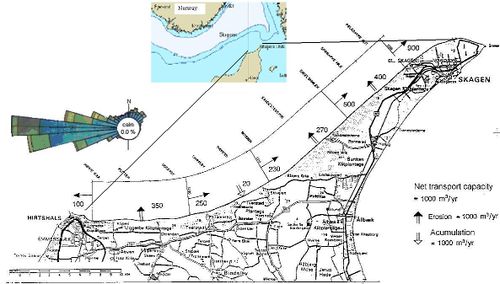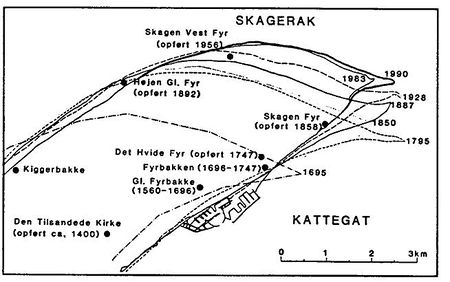Difference between revisions of "Natural causes of coastal erosion"
| Line 4: | Line 4: | ||
One cause of natural coastal erosion is an increasing gradient in transport rate in the direction of the net transport. This can be due to gradients in the wave conditions at certain stretches, a curved coastline, or special bathymetric conditions. An example of this kind of coastal condition is the West Coast of Skaw Spit, the northernmost tip of Denmark. The presence of the headland and the port at Hirtshals, combined with the shadow effect of southern Norway, results in increasing transport along the section of coastline some kilometres east of Hirtshals to Gammel Skagen. For this reason the entire NW-oriented section of the Skaw spit is exposed to erosion. | One cause of natural coastal erosion is an increasing gradient in transport rate in the direction of the net transport. This can be due to gradients in the wave conditions at certain stretches, a curved coastline, or special bathymetric conditions. An example of this kind of coastal condition is the West Coast of Skaw Spit, the northernmost tip of Denmark. The presence of the headland and the port at Hirtshals, combined with the shadow effect of southern Norway, results in increasing transport along the section of coastline some kilometres east of Hirtshals to Gammel Skagen. For this reason the entire NW-oriented section of the Skaw spit is exposed to erosion. | ||
| − | [[Image:increasing littoral drift rate_b.jpg|center|500px| Increasing littoral drift rate along Skaw Spit, Denmark. This causes coastal erosion along the entire 25 km long section.]] | + | [[Image:increasing littoral drift rate_b.jpg|center|thumb|500px|Fig. 1. Increasing littoral drift rate along Skaw Spit, Denmark. This causes coastal erosion along the entire 25 km long section.]] |
| − | |||
==Loss of sand== | ==Loss of sand== | ||
| Line 39: | Line 38: | ||
features in the deposition areas, but the upstream coastline has lost the | features in the deposition areas, but the upstream coastline has lost the | ||
sand. An example of this is the Skaw Spit, see Fig. 3. below. | sand. An example of this is the Skaw Spit, see Fig. 3. below. | ||
| − | [[Image:skaw spit.jpg|450px|center|Sand deposition at the north beach at Skaw Spit and corresponding loss of sand from the downstream beach.]] | + | [[Image:skaw spit.jpg|450px|center|thumb|Fig. 3. Sand deposition at the north beach at Skaw Spit and corresponding loss of sand from the downstream beach.]] |
| − | |||
==Protuding areas== | ==Protuding areas== | ||
The loss of material from a protruding area to one or two sides is a natural cause of coastal erosion. This typically happens at till/sandstone headlands and at the tip of deltas, which do not receive sufficient material from the river due to natural shifting of the river alignment. Delta erosion can also be caused by human impact, which will be discussed later. It also occurs along semi-hard concave-shaped sections of coastline, which have no or only a small supply of sand from rivers. The natural state of such a coastline is erosion and straightening; the straightened coastline is referred to as a simplificated coast, see Fig. 4. | The loss of material from a protruding area to one or two sides is a natural cause of coastal erosion. This typically happens at till/sandstone headlands and at the tip of deltas, which do not receive sufficient material from the river due to natural shifting of the river alignment. Delta erosion can also be caused by human impact, which will be discussed later. It also occurs along semi-hard concave-shaped sections of coastline, which have no or only a small supply of sand from rivers. The natural state of such a coastline is erosion and straightening; the straightened coastline is referred to as a simplificated coast, see Fig. 4. | ||
| − | [[Image:NWNZ.jpg|500px|centre| | + | [[Image:NWNZ.jpg|500px|centre|thumb|Fig. 4. The NW coast of North Zealand, Denmark, an example of a simplificated coast; the moraine landscape (red) has been cut back to a nearly straight line, marine platform (yellow) has been formed in between.]] |
| − | + | ||
==Marine deposit shorelines== | ==Marine deposit shorelines== | ||
Revision as of 05:52, 19 March 2007
Natural coastal erosion is caused by many factors which are discussed in detail in this article.
Contents
Transport gradient
One cause of natural coastal erosion is an increasing gradient in transport rate in the direction of the net transport. This can be due to gradients in the wave conditions at certain stretches, a curved coastline, or special bathymetric conditions. An example of this kind of coastal condition is the West Coast of Skaw Spit, the northernmost tip of Denmark. The presence of the headland and the port at Hirtshals, combined with the shadow effect of southern Norway, results in increasing transport along the section of coastline some kilometres east of Hirtshals to Gammel Skagen. For this reason the entire NW-oriented section of the Skaw spit is exposed to erosion.
Loss of sand
Causes of coastal erosion due to loss of sand may come under the following circumstances:
Breaching and over-wash
The loss of sand inland due to breaching and over-wash of a barrier island and wind transport. This kind of sand loss takes place along the exposed coast of Skallingen barrier island on the southern part of the Danish North Sea coast, see Fig. 2.
Extreme wave and storm surge conditions
Offshore loss during extreme wave and storm surge conditions. The high waves cause the bars to move seawards and the high storm surges also cause an offshore movement of sand due to non-equilibrium in the profile during the high surge.
Canyons
The loss of sand into canyons. If there is a deep canyon close to a littoral transport coastline, sand may be lost into the canyon.
Accumulative beaches
The loss of sand to an accumulative beach at the tip of a sand spit and into deep water at the leeward of the tip of a sand spit at the termination point of a littoral cell. Sand lost in this way causes accumulative shore and shoal features in the deposition areas, but the upstream coastline has lost the sand. An example of this is the Skaw Spit, see Fig. 3. below.
Protuding areas
The loss of material from a protruding area to one or two sides is a natural cause of coastal erosion. This typically happens at till/sandstone headlands and at the tip of deltas, which do not receive sufficient material from the river due to natural shifting of the river alignment. Delta erosion can also be caused by human impact, which will be discussed later. It also occurs along semi-hard concave-shaped sections of coastline, which have no or only a small supply of sand from rivers. The natural state of such a coastline is erosion and straightening; the straightened coastline is referred to as a simplificated coast, see Fig. 4.
Marine deposit shorelines
Erosion can occur of the marine deposit shorelines suspended between sections of protruding semi-hard sections of the coastline, such as till or sandstone. The hard sections have historically provided material for building up the sedimentary shorelines. The shape of these shorelines is consequently dependent on the presence of the semi-hard sections and the wave climate. However, as the semi-hard sections continue to erode, the sedimentary shorelines will follow suit despite the fact that they were originally accumulative forms. This development is part of the simplificated coast (see Protruding Areas section, above).
Downstream erosion of accumulative forms
Another cause of natural coastal erosion is the erosion downstream of accumulative forms at coastlines with very oblique wave approach, coast types 4M, 4E, 5M and 5E. Along such coastlines there is a tendency for the natural formation of spit formations parallel to the coast. They accumulate the sand and shift the sand supply offshore, which means that the downstream coastline is starved and begins to erode, see Fig. 5., an example of the formation of a sand spit formation parallel to the coast, which starves the downstream coastline. Note that there is no sand accumulation west of the port because the sand is trapped in the sand spit further upstream.
Sea level rise
A world-wide sea level rise is a phenomenon, which has been discussed for decades. A global sea level rise of 0.1 to 0.25 m was recorded over the last century. The forecast for the global sea level rise for the next century varies considerably; however, with a central estimate of 0.2 m and 0.5 m at the middle and end of the 21st century, respectively, according to Intergovernmental Panel on Climate Change, IPCC[1]. An increasing sea level will cause a shoreline setback, which is approximately equal to the sea level rise divided by the slope of the active coastal profile, when considering equilibrium profiles. Consider, for example, a sea level rise of 0.5 m and an equilibrium coastal profile with a slope of the shoreface and the shore of 1/100. The setback caused by such a sea level rise will be 50 m. Littoral coasts consisting of fine sediments will be exposed to higher setbacks than coasts consisting of coarser sediments.
Subsidence
Subsidence lowers the surface in a specific region. Subsidence is a local/regional phenomenon in contrast to the sea level rise, which is global. Subsidence can be caused by many different phenomena, natural as well as human. Natural causes can be the settling of soft sediments, tectonic activity and different kinds of rebound processes, whereas human causes can be the extraction of groundwater, oil or gas in the coastal area. Subsidence acts in the same way as sea level rise in relation to shore erosion apart from the fact that a sea level rise will always be a gradual and slow process, whereas subsidence may occur rapidly depending on the cause of the subsidence.
Natural variation
The natural variation in the supply of sand to a coastline from a river can contribute to erosion. Droughts in large river basins can result in long periods with decreasing supplies of sand to the shoreline, leading to shore erosion. The historic large variations in the shorelines of the Nile delta were partly due to this situation, whereas the more recent erosion is mainly the result of human interventions along the Nile.
References
Further reading
- Mangor, Karsten. 2004. “Shoreline Management Guidelines”. DHI Water and Environment, 294pg.
return to




